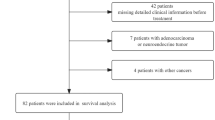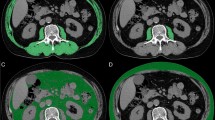Abstract
Background/Objectives:
Cancer cachexia is a syndrome characterized by weight loss (WL) and sarcopenia. Aim of the study was to assess the impact of cachexia on head and neck changes during definitive cisplatin and image-guided volumetric-modulated arc radiation therapy in a series of locally advanced oropharyngeal cancer.
Subjects/Methods:
Volume variations of sternocleidomastoid muscle (SCM) were considered as surrogate of muscle changes related to sarcopenia. Two head and neck diameters, encompassing the cranial limits of II and III nodal levels (defined as ‘head diameter’ and ‘neck diameter’, respectively), were measured. All parameters were defined retrospectively by means of on-board cone beam computed tomography images at 1-8th to 15–22th and at last fraction (fx) of radiotherapy (RT). Cachexia was defined as WL >5% during treatment. Analysis was conducted correlating the parameter changes with three WL ranges: <5, 5–9 and>10%.
Results:
Thirty patients were evaluated. One hundred and fifty contoured SCMs and three hundred diameters were collected. Median WL was 6.5% (range, 0–16%). The most significant SCM shrinkage was recorded at 15th fx (mean 1.6 cc) related to WL 5–9% and WL >10% (P 0.001). For ‘head diameter’, the peak reduction was recorded at the 15th fx (mean 8 mm), statistically correlated to WL >10% (P 0.001). The peak reduction in ‘neck diameter’ was registered at the 22th fx (mean 6 mm), with a gradual reduction until the end of treatment for WL >5%.
Conclusions:
In a homogeneous cohort of patients, present study quantified the impact of cachexia on head and neck changes. Present data could provide adaptive RT implications for further investigations.
This is a preview of subscription content, access via your institution
Access options
Subscribe to this journal
Receive 12 print issues and online access
$259.00 per year
only $21.58 per issue
Buy this article
- Purchase on Springer Link
- Instant access to full article PDF
Prices may be subject to local taxes which are calculated during checkout


Similar content being viewed by others
References
Burckart K, Beca S, Urban RJ, Sheffield-Moore M . Pathogenesis of muscle wasting in cancer cachexia: targeted anabolic and anticatabolic therapies. Curr Opin Clin Nutr Metab Care 2010; 13: 410–416.
Kotler DP . Cachexia. Ann Intern Med 2000; 133: 622–634.
Kubrak C, Olson K, Jha N, Jensen L, McCargar L, Seikaly H et al. Nutrition impact symptoms: key determinants of reduced dietary intake, weight loss, and reduced functional capacity of patients with head and neck cancer before treatment. Head Neck 2010; 32: 290–300.
Cacicedo J, Dal Pra A, Alongi F, Navarro A . Impact of weight loss in patients with head and neck carcinoma undergoing radiotherapy: is it an underestimated phenomenon? A radiation oncologist's perspective. Eur J Clin Nutr 2015; 69: 757–760.
Ricchetti F, Wu B, McNutt T, Wong J, Forastiere A, Marur S et al. Volumetric change of selected organs at risk during IMRT for oropharyngeal cancer. Int J Radiat Oncol Biol Phys 2011; 80: 161–168.
Schwartz DL, Garden AS, Shah SJ, Chronowski G, Sejpal S, Rosenthal DI et al. Adaptive radiotherapy for head and neck cancer dosimetric results from a prospective clinical trial. Radiother Oncol 2013; 106: 80–84.
Schubert LK, Westerly DC, Tomé WA, Mehta MP, Soisson ET, Mackie TR et al. A comprehensive assessment by tumor site of patient setup using daily MVCT imaging from more than 3800 helical tomotherapy treatments. Int J Radiat Oncol Biol Phys 2009; 73: 1260–1269.
O’Daniel JC, Garden AS, Schwartz DL, Wang H, Ang KK, Ahamad A et al. Parotid gland dose in intensity modulated radiotherapy for head and neck cancer: is what you plan what you get? Int J Radiat Oncol Biol Phys 2007; 69: 1290–1296.
Barker Jr JL, Garden AS, Ang KK, O'Daniel JC, Wang H, Court LE et al. Quantification of volumetric and geometric changes occurring during fractionated radiotherapy for head-and neck cancer using an integrated CT/linear accelerator system. Int J Radiat Oncol Biol Phys 2004; 59: 960–970.
Jaffray DA, Siewerdsen JH, Wong JW, Martinez AA . Flat-panel cone-beam computed tomography for image-guided radiation therapy. Int J Radiat Oncol Biol Phys 2002; 53: 1337–1349.
Sanguineti G, Rao N, Gunn B, Ricchetti F, Fiorino C . Predictors of PEG dependence after IMRT±chemotherapy for oropharyngeal cancer. Radiother Oncol 2013; 107: 300–304.
Grégoire V, Levendag P, Ang KK, Bernier J, Braaksma M, Budach V et al. CT-based delineation of lymph node levels and related CTVs in the node-negative neck: DAHANCA, EORTC, GORTEC, NCIC,RTOG consensus guidelines. Radiother Oncol 2003; 69: 227–236.
Grégoire V, Eisbruch A, Hamoir M, Levendag P . Proposal for the delineation of the nodal CTV in the node-positive and the post-operative neck. Radiother Oncol 2006; 79: 15–20.
Hamoir M, Leemans CR, Dolivet G, Schmitz S, Grégoire V, Andry G . Selective neck dissection in the management of the neck after (chemo)radiotherapy for advanced head and neck cancer. Proposal for a classification update. Head Neck 2010; 32: 816–819.
Mazzola R, Ricchetti F, Fiorentino A, Fersino S, Giaj Levra N, Naccarato S et al. Dose-volume-related dysphagia after constrictor muscles definition in head and neck cancer intensity-modulated radiation treatment. Br J Radiol 2014; 87: 20140543.
Ding GX, Munro P, Pawlowski J, Malcom A, Coffey CW . Reducing radiation exposure to patients from kv-CBCT imaging. Radiother Oncol 2010; 97: 585–592.
Basch E, Prestrud AA, Hesketh PJ, Kris MG, Feyer PC, Somerfield MR et al. Antiemetics: American Society of Clinical Oncology clinical practice guideline update. J Clin Oncol 2011; 29: 4189 Erratum in: J Clin Oncol 2014; 32: 2117.
Fiorentino A, Cozzolino M, Caivano R, Pedicini P, Oliviero C, Chiumento C et al. Head and neck intensity modulated radiotherapy parotid glands: time of re-planning. Radiol Med 2014; 119: 201–207.
Bhide SA, Davies M, Burke K, McNair HA, Hansen V, Barbachano Y et al. Weekly volume and dosimetric changes during chemoradiotherapy with intensity modulated radiation therapy for head and neck cancer: a prospective observational study. Int J Radiat Oncol Biol Phys 2010; 76: 1360–1368.
Fearon K, Strasser F, Anker SD, Bosaeus I, Bruera E, Fainsinger RL et al. Definition and classification of cancer cachexia: an international consensus. Lancet Oncol 2011; 12: 489–495.
Gillette EL, Mahler PA, Powers BE, Gillette SM, Vujaskovic Z . Late radiation injury to muscle and peripheral nerves. Int J Radiat Oncol Biol Phys 1995; 31: 1309–1318.
Cacicedo J, Perez JF, Ortiz de Zarate R, del Hoyo O, Casquero F, Gómez-Iturriaga A et al. A prospective analysis of inter- and intrafractional errors to calculate CTV to PTV margins in head and neck patients. Clin Transl Oncol 2015; 17: 113–120.
Mazzola R, Ricchetti F, Fersino S, Fiorentino A, Giaj Levra N, Di Paola G et al. Predictors of mucositis in oropharyngeal and oral cavity cancer in patients treated with volumetric modulated radiation treatment: A dose-volume analysis. Head Neck 2015, e-pub ahead of print 27 April 2015 doi:10.1002/hed.24106.
Author information
Authors and Affiliations
Corresponding author
Ethics declarations
Competing interests
The authors declare no conflict of interest.
Additional information
Author contributions
RM and FA conceived the research idea; GDP performed the statistical analysis. All authors designed the research, wrote the paper, read and approved the final manuscript.
Rights and permissions
About this article
Cite this article
Mazzola, R., Ricchetti, F., Fiorentino, A. et al. Cachexia induces head and neck changes in locally advanced oropharyngeal carcinoma during definitive cisplatin and image-guided volumetric-modulated arc radiation therapy. Eur J Clin Nutr 70, 738–742 (2016). https://doi.org/10.1038/ejcn.2016.61
Received:
Revised:
Accepted:
Published:
Issue Date:
DOI: https://doi.org/10.1038/ejcn.2016.61
This article is cited by
-
Fentanyl pectin nasal spray for painful mucositis in head and neck cancers during intensity-modulated radiation therapy with or without chemotherapy
Clinical and Translational Oncology (2017)
-
18F-Fluorodeoxyglucose-PET/CT in locally advanced head and neck cancer can influence the stage migration and nodal radiation treatment volumes
La radiologia medica (2017)



